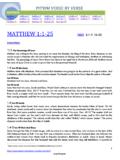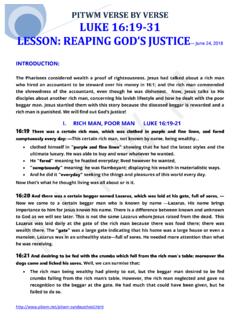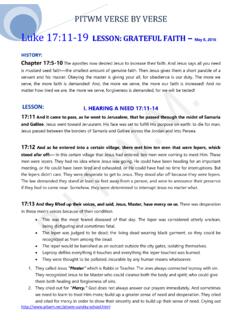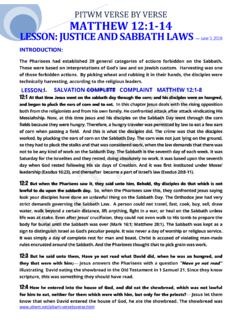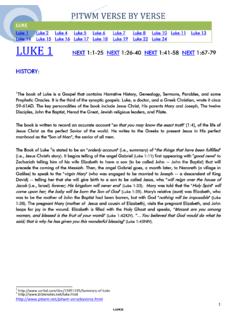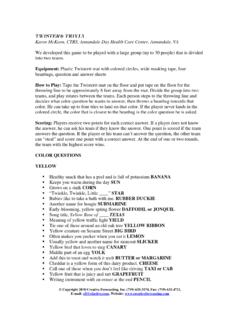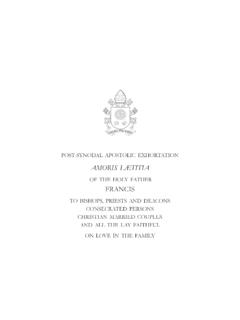Transcription of PITWM VERSE BY VERSE
1 PITWM VERSE BY VERSE John 2:1-12 HISTORY: 1 The Gospel of John opens with the familiar Prologue (1:1-18), which is followed in chapter one with four texts: (1) John's witness to the Christ (1:19-28); (2) the first "next day" text identifying titles of Jesus by John (1:29-34); (3) the second "next day" text with the invitation and promise of Jesus (1:35-42); (4) the third "next day" text with the invitations of Jesus to Philip and Nathanael and the promise of the Son of Man (1:43-51). 2:1 And the third day there was a marriage in Cana of Galilee; and the mother of Jesus was there. Now, we go to the third day after Jesus has gathered His disciples. They are all in for a delight. It will demonstrate one of His very purposes for coming to earth: to reveal the creative power of God. He had the power to create and produce what was needed to meet man s need.
2 2 Jesus with His six new disciples traveled from Bethany near Jericho, to Nathaniel s hometown of Cana in Galilee, which is about a two days journey on foot. Cana is a small remote, obscure country village in the highlands of Galilee. There is a most joyous celebration of a marriage taking place. So on the third day of Jesus journey He finds Himself His disciples, and Mary, Jesus mother invited to a joyous wedding. This was the place of the beginning of His first miracle! 2:2 And both Jesus was called, and his disciples, to the marriage. Jesus and His disciples are in attendance of this most joyous and festive occasion by invitation; one of the largest social events in a community. This tells us two things about Jesus. 1. Jesus was a sociable person: He likes people and people liked Him. His ministry was focused on being with and helping people all He could.
3 2. Jesus honored marriage. He demonstrated His approval and honor by attending the marriage feast and by meeting the urgent need of the bridegroom. 2:3 And when they wanted wine, the mother of Jesus saith unto him, They have no wine. A Jewish wedding ceremony included three major events: 1. There was a marriage feast and ceremony which were held on the same evening. 2. There was the escort of the couple through the streets to their home; usually taking place at night with flaming torches to light the way. 3. There was the open house which lasted for a week. All week long the couple wore their wedding garments (gown and robe) and entertaining guests. The whole community was expected to participate and celebrate with the couple in their new found happiness. Now an issue has arisen! There are three concerns: 1. The couple s concern: The wine has run out and the celebration had just begun.
4 There was a whole week of celebration yet to go. 1 2 PITWM VERSE BY VERSE 2. Mary s concern: Mary wanted things to go well for the couple and brings this concern to Jesus. "There is no wine!" 3. Jesus concern: He still had to teach and prepare His mother and disciples for His greater purpose. 2:4 Jesus saith unto her, Woman, what have I to do with thee? mine hour is not yet come. At this point, Jesus replies in a stern manner but not with disrespect. Mary focused on the social need (physical and material); while Jesus focused on the deeper need (soul and spirit; bearing the sins of the world for man). He calls her "woman", not mother. 3To have addressed her as "mother" would have called attention to human relationships; but calling her "woman" showed that God (deity) was speaking to her.
5 We can also see that the mother and son relationship was changing. He had to hear from His Father. We may add that it is significant that the two times Christ addressed His mother as "woman" are both recorded in the Gospel of John which sets forth His Deity. To say "My" hour has not come was saying, 4"I am not quite ready to launch into the miracles at this time". Nevertheless, Jesus listens to Mary and has feelings for the host. The stage is set! 1. The hour has not yet come when He could really meet man s needs marked by the Father. 2. The hour has not yet come when He must die for man s regeneration marked by the Father. 2:5 His mother saith unto the servants, Whatsoever he saith unto you, do it. No matter what Jesus said to her, her speech said it all. Her confidence was in her Son and she didn t back down.
6 She was willing to let Him do whatever He pleased. Of course, Jesus could attempt to get a merchant to reopen his shop and meet the need, or He could try to secure wine from some neighbors. However, the servants were to do whatever Jesus said. 2:6 And there were set there six waterpots of stone, after the manner of the purifying of the Jews, containing two or three firkins apiece. Six is the number of man, for it was on the sixth day man was made and there were six waterpots standing there, not seven, the perfect number, but six. The six waterpots were used for the purifying and cleansing of the Jews, that is, the ceremonial and religious cleansing of the hands and utensils which represent Judaism ritual. Their smaller waterpots were used by women to transport water from wells. Each of these six stone waterpots could contain about eighteen to twenty-seven gallons each.
7 The word "firkin" relates to brewing measure; a unit of liquid measure is equivalent to eight or nine gallows. These waterpots were empty just as their rituals. Jesus uses their ritual containers and causes a miracle. 2:7 Jesus saith unto them, Fill the waterpots with water. And they filled them up to the brim. First instruction: fill the waterpots. Just as they had heard Mary say, whatever he says do it , they did it by filling them to the brim; not with wine but with water. They didn t ask any questions about where is the wine? or how much should we fill the pots? 5 Jesus didn t need the servants help to perform this miracle. He could have miraculously filled the jars with wine without their first filling them with water. 3 4 5 John-God s Word for the Biblically-inept series PITWM VERSE BY VERSE But He chose to include people in His work, just as He chooses to include us now.
8 He uses us in small and large roles to accomplish His purposes and demonstrate His power to the world. 2:8 And he saith unto them. Draw out now, and bear unto the governor of the feast. And they bare it. Second instruction: "draw out", which refers to dipping out the water. Third instruction: bear unto the governor of the feast (the head person in charge; the master of the waiters or servants; the master of the banquet). That was all that was said and done. There was no delay of Jesus inspecting the water or passing His hand over the water. Faith always continues to present miracles in our lives. I believe Mary s faith started it off. The servant s obedience continued it as they were on one accord in doing what Jesus commanded. Now, the proof was now for the master of the banquet to taste. 2:9 When the ruler of the feast had tasted the water that was made wine, and knew not whence it was: (but the servants which drew the water knew;) the governor of the feast called the bridegroom, This miracle was really viewed by the servants that drew the water into the waterpots, and of course His disciples.
9 The governor of the feast only was witness to the taste of this magnificent wine in which he assumed the bridegroom had supplied. By the time he tasted it, it was no longer water but wine. Jesus did not wave His hand over it, or even touch the waterpots. The only ones to touch the pots were the servants. This was truly a miracle, but Jesus did not call attention to Himself. 2:10 And saith unto him, Every man at the beginning doth set forth good wine; and when men have well drunk, then that which is worse: but thou hast kept the good wine until now. The wine was of a more superior quality when it was tasted. The governor of the feast compliments the bridegroom. Contrary to normal custom, the good wine was served at the beginning of the feast and the cheaper wine after the guest has had their fill.
10 6 After they had well drunk, their senses would have been dulled and they would have not known one wine from the other. This new wine was not of this world. This is like the best was kept until last. This is what God did. He first sent His prophets and judges to bring the people to the knowledge of God, but the best was saved until the last, when God sent His only begotten Son. I believe this whole incident was kept quiet because Jesus was not ready to be exposed as Messiah at that moment. The servants knew, the disciples knew, Mary knew, and Jesus knew, but I find nowhere in this discourse where the crowd at the party or anyone in authority knew. 2:11 This beginning of miracles did Jesus in Cana of Galilee, and manifested forth his glory; and his disciples believed on him. "Beginning" means first. The word used here for "miracles" (Gr s meion) means "signs.
